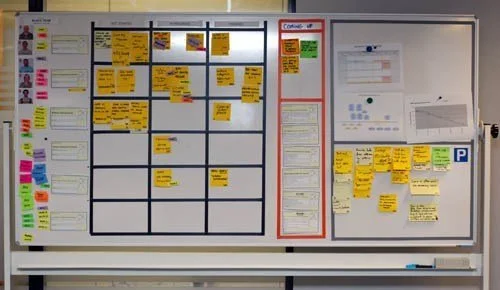Visible workspaces – a house of cards or something far more solid?
Many people’s first encounter with an implementation of an Agile framework is the visible workspace. I find first reactions to this very telling: for some it feels like a natural way of expressing their work and they can see what is happening in an instant, while for others it’s some cards on a wall that don’t look professional and ”what’s this got to do with real planning anyway”. The professional part of me hides that sinking feeling inside when you know how much energy you are going to have to put in to get them to see that Gantt does not always (even rarely) equal a plan that works.
So for those who don’t know what a visible work space is here is a short list of what it is and what it is not. A visible workspace is:
A focal point for the project team, especially during a horizon
A representation of the work planned for the iteration
An easy way to see who is doing what and when
A planning tool for the team
A repository for non sprint information too, such as highlighting levels of technical debt
A living document
Easy to understand for anyone in the organisation
A visible workspace is not:
A tool for the team to report to a project manager with
Something you do at the start of the project and forget about
A place for management to pick holes in your project
Full of lies and things you can’t commit too
The image below is a good example of a visible workspace:
So, it’s just a board with some cards on it. What’s so special about that? Well not much but it’s how you use it that makes it special. If you look at the Agile manifesto it turns a board with cards the represent “doing Agile” and makes it into “being Agile”. What do I mean by that?
All of the Agile methods, practices and frameworks that we enjoy using were founded on the principles set out in the Agile manifesto, but we often forget that in our daily life. If you read books on Agile and go on your Scrum Master training, generally the manifesto gets mentioned explicitly at the start, but then the values are implied for the rest of the time. So if all you take from this is that you need a visible workspace, then that’s all you get. What you miss is why.
But if you think “we need a visible workspace” and keep in your head a few points, then you get a different thing:
From the Agile Manifesto:
“Individuals and interactions over processes and tools”
From the twelve principles behind the manifesto:
“Business people and developers must work together daily throughout the project”
“The most efficient and effective method of conveying information to and within a development team is face-to-face conversation”
“Simplicity–the art of maximizing the amount of work not done–is essential”
This makes for a totally different experience.
Individuals and interactions over processes and tools
I think i like this bit best: whilst the visible workspace is definitely a tool and has processes it enhances and encourages interactions between individuals.
Business people and developers must work together daily throughout the project
One of the fundamental reasons behind user stories is that both the dev team and the business can read and understand the same feature. So having a easy to find board with this iterations development goals on it in a format for the whole team is really important.
It’s not just the features under development that are important to working together, burndown charts and impediments are much easier to interpret and read than issue logs and a 400 line Gantt chart.
The most efficient and effective method of conveying information to and within a development team is face-to-face conversation
Stand ups really matter and having them in front of a board stimulates both face to face communication and effective daily planning.
Simplicity–the art of maximizing the amount of work not done–is essential
The board in the diagram looks busy, but it is not is wasteful. Aside from things like Continuous Integration and bug tracking, everything you need to run the project is here for the current iteration. It’s the minimum amount of process and documentation / reporting to allow the team succeed and deliver high quality working software.
So to sum up a visible workspace should not just be seen as a place to keep the cards, but really seen as the team camp fire, a focal place where people talk about stories and what happened that day, plan the next day and enjoy each others company.

